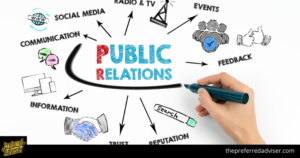The study found that it is more difficult to get a response from prospects, connect via cold email, and close deals than it used to be a few years ago.
This guide will cover everything you need to know to create successful cold email campaigns that will generate new leads and boost sales.
Cold Email Outreach
There are many benefits to cold emailing potential customers, including the low cost and high effectiveness compared to other outbound sales techniques.
A cold email is a personalized email message sent to a prospective customer with whom you have had no previous contact. Its purpose is to initiate a conversation and kickstart a relationship.
Perfect Cold Email Outreach Campaign: All the Necessary Steps
1. Prepare for Cold Email Outreach by Setting Your Goals
 The first step to an effective cold email campaign is to determine the desired results. By planning carefully, you can achieve the goals you set for the campaign.
The first step to an effective cold email campaign is to determine the desired results. By planning carefully, you can achieve the goals you set for the campaign.
What is your ideal outcome for this campaign?
Answering the questions below will help you gain clarity over your goals:
- What product or service are you selling? (make your offering specific – go for a single goal)
- Who would be interested in your offering? i.e. which company to approach, whom exactly to email there – define your Ideal Customer Profile (ICP) and Buyer Personas.
- When is the perfect moment for reaching out to your prospects?
- How many follow-up emails are you going to send them and in what sequence?
- Gather in-depth insights into your prospects’ current objectives, needs, and issues, how your product or service can help them to resolve their problem, what motivates them, etc. so that you can personalize your cold email pitch.
- Create a system to keep track of every prospect (which step each one is currently in and what your following steps with them involve) and the effectiveness of your campaign (open, response, click-through rates, etc.)?
2. Identify Your Potential Customers
You want your email to be seen as legitimate, not spam. Don’t rely on guessing when planning your campaign.
It’s important to do your research and identify your potential customers carefully. The more you know about what they want and what their goals are, the more successful your cold email campaign will be.
The first step is to identify the right person in the company to speak to in order to get the information you need. This may require some research on the company’s website or a phone call to the company’s main line to determine the right department to speak to.
You can identify your potential customers in different ways such as:
- Performing research to build custom B2B lead lists.
- Checking their LinkedIn profiles to find out more about their interests and careers.
- Searching for Tweets where people are asking for help with a problem you may help them solve.
- Exploring relevant Facebook Fan Pages where people may ask for the help you can provide with your specific product or service.
- Asking your existing customers for referrals.
- Finding your competitors’ customers will help you understand who your customers could be.
- Review job descriptions of your ideal prospects if you’re targeting a B2B audience.
3. Craft Compelling Cold Email Copy
Your cold email should evoke a strong desire in the recipient to do what you want them to do.
Spark Curiosity With a Killer Subject Line, Preview Text and Opening Line for Better Opening Rates
The key is in making your cold email subject lines:
- Super clear
- Brief (preferably under five words i.e. up to 60 characters)
- Informative
- Highly relevant to your prospect’s needs (presenting how your solution can help them without any fake promises or trying to oversell)
- Compelling (be careful to avoid spammy language e.g. symbols like $$$, !!!!!, and words like free, discount and similar)
- Original
- Natural
- Personalized and
- Evoke a sense of urgency.
Other valuable tips and tricks on this topic may not work for everyone, so it is important to test different methods until you find the ones that work best for you specifically.
Include a Precise CTA
Your goal with a call-to-action is to convince the recipient to take the desired action.
What is it that you would like your recipients to do after reading your email?
- Do you want them to realize they need your service and pay you for it?
- Buy your product?
- Become your affiliate?
- Sign up for your software?
- Arrange a demo or meeting with you?
The important thing is to create a clear and specific call to action so that you don’t make your potential customers guess. Don’t ever assume they’ll figure out for themselves what your next step is.
Personalize Your Cold Email Messages the Right Way
How to Personalize Your Email Messages the Right Way?
The first step of creating a well-personalized cold email is to make a database of your recipients’ needs and wants and use that information to benefit and engage them.
As a foundation for your highly tailored messages, besides names, it’s helpful to discover more details such as your recipients’:
- Location
- Job title
- Interests and hobbies
- Favorites (animals, colors, sports, etc.)
- School/university they went to
- Common connections
- Club memberships
- Recent challenges
- Accomplishments
- Mentions on websites, videos, podcasts, or webinars
Include a few personal details in your email copy so that they fit in well with the rest of the message. Try not to use more than three pieces of personal information from the recipient in one email.
Include a Professional Email Signature
Many people often overlook the last chance to make a good impression – an interesting, creative and memorable sign-off accompanied by a professional email signature that should contain your:
- Name
- Current position within the company
- Physical address
- Phone number
- Company website link
Before you send an email, it’s always a good idea to perform a quick check to make sure the message makes sense and contains no errors. This is especially important if you’re sending an important email to someone you don’t know very well.
When you want to create an exceptionally effective cold email, you need to make sure that:
- You know what you want to achieve with your cold email and it’s clearly stated to the recipient too
- You’re emailing the right person in the right company department and position and that they’re your ideal target prospect
- Your cold email copy (including all its elements such as e.g. subject line, CTA or signature) is highly relevant to the recipient, attention-grabbing, properly personalized, straightforward, ultra-specific and persuasive
- You never forget to proofread your cold email copy thoroughly and perform a sanity check before you send it
- Your email doesn’t contain any spammy elements
- The timing for sending your cold email is perfect
- You remember to follow up
- You split test every bit of your cold email and measure the results until you find the magic formula that drives conversions for you.
4. Remember to Send Follow-Up Emails
 You don’t want to come on too strong when you reach out to potential customers for the first time in a cold email. sales pitch.
You don’t want to come on too strong when you reach out to potential customers for the first time in a cold email. sales pitch.
The author is saying that trying to close a deal right away is not a good idea, and that it’s better to take the time to build a relationship with the person first.
This means that you shouldn’t give up after sending the first message, but should always send follow-up emails.
Not following up with potential customers is a common mistake that marketers and salespeople make.
Split testing your emails allows you to discover which emails perform the best so that you can send more of those in the future.
To determine the success of your cold email message, it’s necessary to track:
- Open rate – to see whether your subject line is working
- Response rate – to figure out whether your message is hitting the bull’s eye
- Conversion rate – if your message is aligned with your sale, higher open and response rates should naturally lead to increased sales.
The more components you split test, the more valuable in-depth insights you’ll get, which will reveal your best-performing pieces. So, you could test your email:
- Subject lines
- Opening lines
- Body copy
- CTAs
- Timing
- Personalization
- The wording of your value proposition
When to Use Cold Emails
1. Lead Generation
A salesperson’s most common use case for cold emailing is generating leads.
Hello potential customer, My name is _____ and I am with _____. We offer _____ and I believe it could be exactly what you are looking for. It has many benefits such as _____. Would you be interested in learning more?
I would be happy to answer any questions you may have. Thank you for your time, _____ Hi there, I’m get in touch to introduce you to our product/service that could be really useful for you. Our product/service has lots of benefits like _____. Would you be interested in learning more? I’d be happy to give you more information and answer any questions. Thanks, _____
If the recipient sees that you and them would work well together, you have a good opportunity to continue the sales conversation.
2. Partnerships
Teaming up with a popular figure or institution can assist you in expanding your clientele and fan base.
Partner emails are a great way to reach out to potential new business opportunities, whether you are looking for referrals or affiliate partners.
You can send a cold email to a potential partner in order to introduce yourself and your proposal. You can explain why you think the partnership would be mutually beneficial and convince them that you would be a good fit.
3. Influencer Marketing
 The benefit of influencer marketing is that it increases brand awareness and creates social proof for a product or service.
The benefit of influencer marketing is that it increases brand awareness and creates social proof for a product or service.
The goal of influencer marketing is to promote a product or service to a large, targeted audience. The benefit of this type of marketing is that it can increase brand awareness and create social proof for the product or service.
You identify relevant influencers in your target niche and reach out to them. Key opinion leaders, bloggers, podcast hosts, YouTubers, and celebrities are all examples of potential influencers.
One way to generate leads for your business is to reach out to influencers and ask for a review, shoutout, or feature on their platforms.
4. Link building
If you have a product or service website with a blog that offers a lot of helpful content, people will be more likely to trust your site and buy from you.
The blog will not be effective for marketing or sales unless the target audience actually visits it.
To improve the visibility of your blog, you might want to try link building.
B2B marketers use link building to drive traffic to their websites and amplify the effects of their content marketing efforts. In link building, a partner blog or channel will add a link to a blog post on your website. This increased traffic can lead to more conversions and sales.
5. Recruiting
A company is only as good as its employees.
To grow quickly, your hiring manager or recruiter needs to actively seek promising candidates for various roles in your organization.
Your recruiter will often find that the best candidates are those who are not actively searching for a job at the moment.
Sending cold emails is a great way to reach out to multiple people who you think would be good for the job, without being too intrusive.
6. Public Relations
 PR is a great way to get a lot of publicity for your product, service, or project.
PR is a great way to get a lot of publicity for your product, service, or project.
If you have anything newsworthy to share with an organization, send a cold email to a journalist asking if they would be interested in covering your story.
If your brand is mentioned in a reputable publication, it can improve your brand image and attract more visitors to your website or social media accounts.
7. Market Research
Cold emails make market research easy.
A marketer can use cold emails to understand the pain points experienced by the target audience or to check a new product’s viability. Additionally, you could use these emails to conduct surveys and gather market research data.
Best Cold Email Practices
1. Keep Your Cold Email Message Concise and to the Point
Your goal as a salesperson when sending cold emails should be to start a conversation, rather than overwhelming your readers.
Keep your emails short and to the point. Include only information that is necessary.
2. Add Some Personality to Your Cold Emails
It’s important that your emails don’t come across as robotic or impersonal. Adding some personality will make them more engaging and will help you build better relationships with your contacts.
One of the quickest ways to build rapport with someone is to address them by their name.
3. Make Cold Emails about the Recipient and Not You
When you are trying to sell something through email, it is likely that you are sending a message to someone you do not know very well.
Instead of focusing on what you have to offer, make the person you are talking to the center of attention. Talk about things they find valuable.
4. Talk about Benefits and Not Features
 It can be tempting to include all of the incredible features your tool offers in a cold email to your ideal customer. However, if your email is too long, they may get bored and fail to realize why any of this matters to them.
It can be tempting to include all of the incredible features your tool offers in a cold email to your ideal customer. However, if your email is too long, they may get bored and fail to realize why any of this matters to them.
Instead of discussing features, discuss how your product or service eases pain points, solves problems, and is valuable assistance.
5. Time Your Cold Emails Right
Your email will get lost among other messages if it arrives when the recipient is not active, resulting in a low open rate.
It is important to send messages to your potential customers when they are most likely to pay attention to them. This is typically around 8 AM, 1 PM, or 5 PM in the time zone of the person you are sending the message to.
6. Always Proofread Your Cold Emails
It’s important to proofread your emails to make sure there are no spelling mistakes or grammatical errors. Check all the links in your email and if there are any images, make sure they load properly.
It is important to also make sure that your emails are able to be read on a mobile device since many people will most likely read them on their phone.
7. Send Cold Emails Only to Qualified Leads
A cold email should only be sent to people who are qualified to receive it, rather than to anyone on a mailing list.
Only send emails to those who could benefit from your service.
To avoid having your emails marked as spam, be thoughtful about who you’re sending emails to.

0 comments